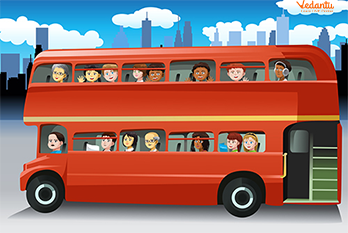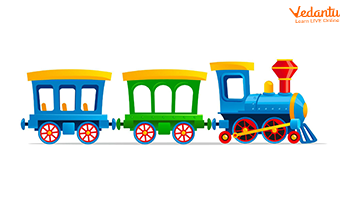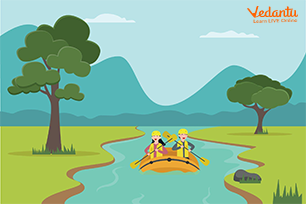




Introduction to Travel and Communication
We all travel from place to place for employment, school, and to see our families, among other things. Every morning, you stand at your bus stop, anticipating the arrival of your school bus. Your school bus transports you to school.
Whenever we have employment, we go from one location to another utilising various modes of transportation. So, let’s read about travelling and communication in our daily lives.
Travel Meaning
The term "travel" refers to the act of moving from one area to another. We travel for a variety of reasons. Depending on the objective of our trip, we go alone, in groups, with our family, or with our classmates. There are numerous purposes such as going to school, college, and so on.
We also travel to distant cities to visit family, spend vacations, and go on school excursions. We either travel alone, such as when our parents go to their offices, or we go with our families, such as when we visit relatives or attend family festivities.
Ways to Travel
There are numerous ways to travel and some of which are explained below;
Travel by Road: Different towns and cities are connected via roads. Buses, motorbikes, cars, trucks, scooters, and other road vehicles are the most frequent modes of travel.

Travel by Rail: Rail transport encompasses all modes of transportation that use rails or tracks. This includes both passenger and freight trains. When compared to vehicle travel, rail transports more people or products.

Travel by Air: Travel by air includes travel by aeroplane, parachute and helicopter. It is the fastest mode of travel that is able to connect all the major cities. Air travel allows you to go to another nation in a matter of hours or days.

Travel by Water: Travelling by boat, ship, or submarine is an example of water travel. Streamers and boats float down major rivers, while ships navigate the oceans and seas, transporting passengers and commodities across continents.

What is Communication?
We communicate with a significant number of people every day. Consider what would happen if no one communicated with one another. We would not be able to communicate our thoughts, ideas, and emotions. Therefore, communication is an integral component of our lives.
Communication Types
Mainly there are two types of communication which are explained below as;
Verbal Communication: Words are used to communicate our thoughts via verbal conversation. Written and oral communication are the two basic types of verbal communication. Written communication comprises handwritten letters, papers, and so on, whereas oral communication includes speeches, lectures, and voice chats, among other things.
Non-verbal Communication: The words aren't included. It's done with facial expressions, body gestures, signs, drawings, graphic designs, etc. Waving a hand, pointing a finger, and smiling are some of its examples.
Communication Methods
The main modes of communication are postal communication, mass communication and telecommunication and these are explained below.
Postal Communication: It involves letter writing. Though writing a letter is not as popular as it once was, it is one of the oldest means of communication. We compose a letter and include the address, then place it in a neighbouring mailbox. Later, a postal worker will collect the letters, sort them, and deliver them to their corresponding addresses.

Telecommunication: Telecommunication refers to long-distance communication. Telegrams, cell phones, and landlines are all examples of telecommunications.

Mass Communication: The transmission or exchange of information to a large number of individuals at the same time is referred to as mass communication. Newspapers, magazines, radio, television, and cinema are examples of numerous forms of mass communication.

Importance of Travel and Communication
The utilisation of natural resources, the mobility of skilled labour, and a rise in agricultural and industrial production are all promoted by travel and communication networks. People in rural regions benefit from travel and communication services since they assist in establishing work prospects.
Solved Questions
1. What is the reason behind travelling?
Ans: We travel only when we have to go to work or to a school for studying or going on vacation. The means of transportation totally depends on the distance that we have to travel. Suppose if we have to travel from one city to another then we choose to prefer bus travelling and if we have to from one country to another then we have to travel by air.
2. What are the various ways through which we can communicate with each other?
Ans: We can communicate in two ways i.e, verbally and non-verbally. In verbal mode, we can express our feelings and thoughts by writing a letter and in the non-verbal mode, we can express our feelings through body gestures and facial expressions.
3. What is the importance of communication?
Ans: It is necessary to communicate in order to express oneself. It also meets one's requirements. Effective communication is necessary for growth in life. Effective communication skills may smooth your path and improve your interactions with people in your daily life by allowing you to understand and be understood by others.
Fun Facts
Do you know that in ancient times, horses and oxen were used for travelling purposes.
In ancient times, the birds were used for communication purposes like sending written messages from one place to another.
Summary
In this article, we have discussed why we need to travel and also about the various ways of travelling. We have mentioned the need for communication and why it is necessary to communicate. The various modes of communication such as verbal and non-verbal modes of communication are also discussed.
Learning By Doing
Think about which type of communication mode is used through television.
For travelling between two towns, which mode of travel would you prefer?
FAQs on Travel and Communication
1. What are travel and communication in simple terms?
Travel, or transportation, is the act of moving people or goods from one place to another using different modes like buses, trains, or aeroplanes. Communication is the process of sharing our ideas, feelings, and information with others through speaking, writing, or using modern devices like phones and computers.
2. Why are the means of transport and communication important for us?
Transport and communication are essential because they connect us with the world. Transport helps us go to school, visit relatives, and allows goods like food and clothes to reach us from far away. Communication helps us stay in touch with family and friends, learn new things, and ask for help in an emergency.
3. What are the three main types of transport? Can you give some examples?
The three main types of transport are:
- Land Transport: Vehicles that move on land. Examples include cars, buses, bicycles, and trains.
- Water Transport: Vehicles that move on water. Examples include ships, boats, and submarines.
- Air Transport: Vehicles that move through the air. Examples include aeroplanes, helicopters, and rockets.
4. What is the difference between personal communication and mass communication?
The main difference is the number of people involved. Personal communication is between two or a few people, like talking on the phone or sending a letter to a friend. Mass communication is when a message is sent to a large number of people at the same time, such as through newspapers, television, or the radio.
5. What are some examples of modern means of communication?
Modern means of communication use technology to send messages instantly across the globe. Some key examples include smartphones for calls and messaging, email for sending written messages and documents, video conferencing for face-to-face talks, and social media for sharing updates with many people.
6. How have the ways we travel and communicate changed over time?
Over time, travel and communication have become much faster and easier. In the past, people used bullock carts or walked for travel, which took a long time. Now, we have fast cars, trains, and aeroplanes. For communication, people used to rely on sending letters by post, which could take days or weeks. Today, we can send an email or make a video call in just a few seconds.
7. How do transport and communication work together to bring things to our homes?
Transport and communication work as a team. For example, when you order a toy online, you use the internet (communication) to place the order. The seller then uses transport (like a truck or aeroplane) to send the toy from their warehouse to your house. Without communication, the order wouldn't be placed, and without transport, it couldn't be delivered.
8. Why is it important to communicate while travelling to a new place?
Communication is very important when travelling to a new place for safety and navigation. We need to communicate to ask for directions if we are lost, read road signs and maps to find our way, and talk to local people to learn about their culture. It also helps us call for help in case of an emergency.
9. Besides talking and writing, what are some other ways people and systems communicate?
We communicate in many ways without using words. Some examples include:
- Traffic Lights: A red light communicates 'stop' and a green light communicates 'go'.
- Hand Gestures: Waving to say hello or goodbye.
- Facial Expressions: A smile communicates happiness, while a frown communicates sadness.
- Sirens: The siren on an ambulance communicates that there is an emergency and other vehicles should give way.
10. For a family trip, when would you choose a train over an aeroplane?
Choosing between a train and an aeroplane depends on the distance and purpose of the trip. You would choose a train for shorter or medium-distance journeys, as it can be cheaper and allows you to see the scenery along the way. An aeroplane is a better choice for very long distances because it is much faster and saves a lot of travel time.





















